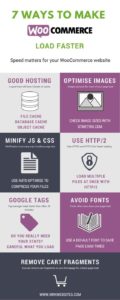7 Ways to Make Your WooCommerce Website Faster
You should know by now that page speed is important. To help you get faster we have put together our 7 tips on how to make your WooCommerce website faster.
The faster the page load, the more likely you will get a sale or lead. This makes page load times even more important for E-Commerce.
At MRK WP, we love WooCommerce and WordPress for our E-Commerce websites. I use WooCommerce as our preferred platform for an E-Commerce store. So let’s jump into the list on how to make your WooCommerce website faster.
We have also put together an Infographic for a quick reference (see below).

Tip 1 – Get a Good Host with 3 Levels of Cache
We use SpinupWP or WP Engine for our WooCommerce WordPress websites. These hosts have an awesome cache tool. You should be looking at cache and speed as your parameters followed by price when selecting a WordPress host.
Why 3 levels of cache? It is the way WordPress works.
You need a file cache – this is for your static files and for static pages. Javascript, CSS and other static files will be in this cache as well as some parts of pages.
You need an object cache – This caches parts of pages or in some cases a whole page and will reduce load time. It avoids having to go to the database.
You need a database cache – it will store queries and database information. It reads data much faster than your normal MySQL page. Many WooCommerce pages or WordPress pages have 30 or more queries. A data cache will speed that up.
SpinupWP has a Redis Object cache, so if you are looking at the best solution for a database cache take a look at SpinupWP (use my referral link for $50 credit).
When it comes to hosting don’t be afraid to spend a bit of money. I’ve seen many sites fail or get low traffic because they are on a low-quality host or the host is not quite good enough.
If you are looking for a cheaper host, look at Chemicloud. These guys have a fast server and easy upgrades at an affordable price.
Remember, the faster the site, the more sales you will get and the easier it is to do SEO and other marketing.
Tip 2 – Optimise Your Images
Image downloads are the largest part of your site, so optimise those images.
You can optimise your images before you upload them. This can take some time. The best option is to use a plugin to optimise them.
I use WP Smush pro. It optimises images on the server with a cloud service. This also optimises thumbnails and all image sizes. Generally, we get fantastic results and it’s a set and forget kind of thing. Do be careful on cheaper hosts with GPU Limits. It burns a lot of GPU time on Siteground Shared Hosting.
Every pixel counts so make sure you are doing as much as possible to reduce your page load. Image resize is another good way to reduce load.
You can check your images with webpagetest.org. Add your URL and you’re ready to see the results of the testing. If you need to resize or compress images this tool will tell you. It also gives a whole host of other insights into your page speed.
Tip 3 – Minify CSS and Javascript
We use Autooptimise for this service. It’s a great free plugin and does a fantastic job on the minification of your files.
Minify your CSS and your javascript. If possible combine your files into single downloads. WP Rocket is also a good choice for this.
If you using SpinupWP they have a good cache tool built into the hosting setup. It makes your site fast but they also have a specific integration with WP Rocket. This means you get a great result because you have a specific combination of features.
Tip 4 – Enable HTTP/2
If you have a good host and an SSL this should already be enabled. How do you check it?
Load up a page in WebPageTest.org and you will see a different load pattern when using http/2. All the files load at once and this gives a huge reduction in page load times.
You will see this in the Waterfall Tab. If you see lots of files starting to download at once – it’s enabled.
You can also try a checker tool that will tell you if your server supports HTTP/2 – https://tools.keycdn.com/http2-test.
Tip 5 – Use Google Tag Manager
Google Tag Manager gives you better load times than using the Google Analytics default method.
Analytics and other scripts all add weight to your page.
Facebook is notorious for slow javascript load times. So if you don’t need Hotjar, retargeting and all those other chat scripts and fancy stats, remove them.
For those you do want, load them with Google Tag Manager and check your load times.
Most Javascript includes adding around 1.5 seconds to your load time so be careful about what you load. If you aren’t using that chat script or Hotjar analytics, remove it. Page load time is more important than stats or features you aren’t using.
I’m also very critical of Javascript for CRM tools. I’ve found them to have low cache time and often slow load times. If you don’t use it, don’t load it.
For anything you do use, stick with Google Tag Manager. It is the best way to load tracking scripts and get asynchronous loading.
Tip 6 – Avoid Google Fonts or Typescript
Actually, avoid fancy fonts. Fonts slow load times and rarely improve on-page conversion. If you can, don’t load a fancy font but use system default ones.
This will save you valuable time. You will save at least half a second by removing fonts.
If you have to use fonts, make sure you load them locally. A good WordPress theme like Kadence Pro will do this for you.
Tip 7 – Remove Cart Fragments
Cart fragments load your WooCommerce cart in the background on every page load.
In all the cases that I have come across, you don’t need this on your homepage. So remove it from your homepage. A simple script in your child theme will do this. It’s pretty simple to put in place and you can check our video screencast here.
This again saves a second or more on full page load.
Important things to remember about making WooCommerce load fast
A good theme and a good host goes a long way to getting WooCommerce to work well for your business.
Be sure to be ruthless about external javascript files and get those images reduced in size.
With these tips, your WooCommerce site will be loading fast. This will help get the sales and conversions that you need.
